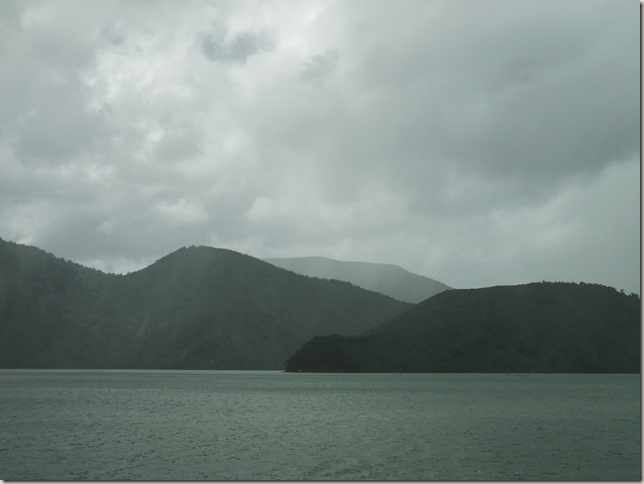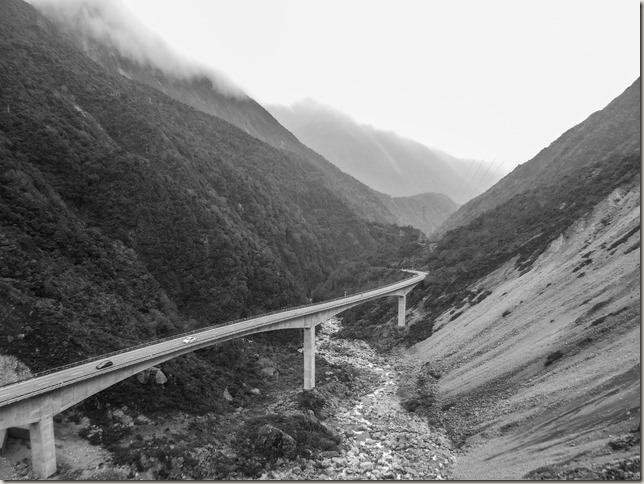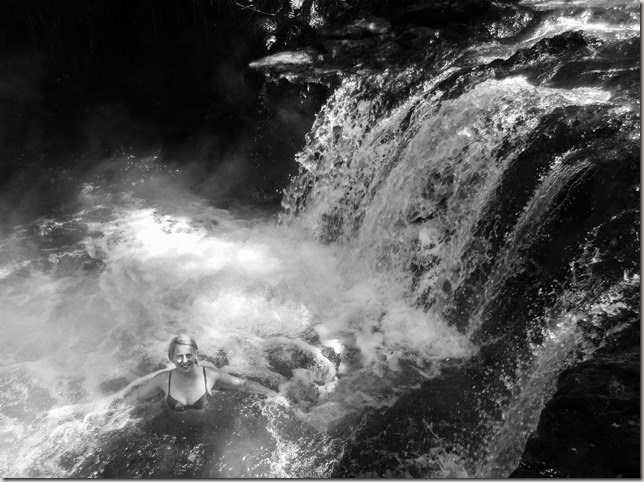Of all the countries I have visited in the world, New Zealand is the one with the best PR.
“LOOK AT THIS PLACE!” The tourist board screams, from the television, from glossy magazines, from billboards on the London Underground (and probably the metro or subway where you live too). “HAVE YOU EVER SEEN ANYTHING LIKE THIS!”

We-ell… actually…

Ok, look. There are lots of beautiful places in the world, some of them jaw-droppingly so, and we’re not about to start trying to play them off against each other. The point is, we were well prepared for New Zealand’s scenery. What we weren’t prepared for were its prices.
Luckily I have relatives in Auckland who we were able to stay with – at least for the first and last parts of our trip – and who generously fed us up with delicious New Zealand lamb and fine wine. But for those lacking in a Kiwi branch to the family, I recommend hiring a campervan.
This was something we had been both looking forward to and slightly dreading. We’d already been travelling for five months and were definitely feeling the challenge of being constantly together. Now, instead of giving each other some space, we were taking things up a notch. For two weeks we would be eating, sleeping, and travelling all within eight square metres. Still, we would have our accommodation and transport covered. And providing we didn’t kill each other, it ought to provide the perfect way to explore this incredible country.
In terms of campsites, you can go from the full complement of facilities (pool, TV room etc) to nothing at all. For the occasional hot shower and communal kitchen we liked Top Ten holiday parks where a non-powered site costs about $40 NZD (£20). For the basic end, check out New Zealand Department of Conservation’s full list of rural camp grounds at www.doc.govt.nz.

Our “Spaceship” came with a small (let’s just say it’s a good thing we’re both under 5’8”) double bed, gas hob, fridge-freezer, a full set of crockery and pots and pans and an array of nifty fold-away storage areas and gadgets. It’s only the size of a family car although if like us you’ve never driven a campervan before, this is a serious plus point. In terms of what they’ve done to make it work – everything folds up and packs away underneath everything else – it’s pretty nifty. But we quickly realised that we were going to have to establish a pretty strict regime if we didn’t want it to become a chaotic mess.

We began our adventure in Auckland, home to more than a quarter of New Zealand’s 4.5 million inhabitants. “This is the last you’ll see of the traffic,” my relatives laughed as we packed up the van. They weren’t kidding. The drive south to Hamilton is only an hour and a half but even on that short stretch we noticed the cars begin to thin out and the road open up before us.
My uncle lent us a GPS but to be honest once you’re out of the city, you don’t really need one – there are at most only two or three directions you could be going in and everywhere is well signposted. If you do go for it, make sure you get one that comes with novelty Kiwi instructions to help you learn the local lingo… who wants to be told “You have reached your destination,” when you could get “Sweet as! Grab your jandals and let’s go!”
That said, actually getting out of Auckland proved trickier than expected and by the time we’d heard the words “Turn around where possible, bro, and let’s go and get ourselves a mean steak and cheese pie,” for the ninth time, we decided to switch it back to plain old Brit.
Our first stop was the Waitomo glow worm caves. We’d heard so many stories about how incredible these caves are that we had decided to go full whack and fork out for the “Lost World” full day Epic Tour (or should that be “Ipuc” Tour?). It ain’t cheap – $412 NZD (£206) each but it does include lunch, a slap up BBQ dinner plus all drinks and snacks. And, to be honest, it is every bit as epic as advertised.

Decked out in wetsuits and wellies, we started the day with a 100-metre abseil down into the caves. After taking a last look at the sunlight we headed upstream, walking, swimming and climbing through caverns, past stalactites and stalagmites, around rocks and up waterfalls.

Then – on the count of three – everyone turned off their torches and the cave was transformed into a magical grotto, dotted with tiny glow worms shining brightly in the darkness.
The following day we drove the two hours to Rotorua, the heart of New Zealand’s volcanic region and home to an array of geothermal attractions. As a self-confessed complete volcano geek this was one of the places I was most excited about. The town itself is not much to shout about and like pretty much every major attraction in New Zealand, it’s eye-wateringly overpriced. There are a plenty of visitor parks to go to but the entrance prices are extortionate and I’m not even going to bother recommending any of them. Those who want them will have no trouble finding them.

We, on the other hand, were imposing strict austerity measures in order to make up for our blow out at the glow worm caves. Luckily there are plenty of ways to experience the volcanic wonders for free, some of which my family tipped me off about, some of which we discovered online but all of which I shall share with you, now:
- Kuirau Park in the centre of Rotorua has an impressive collection of steaming rocks, sulphurous ditches and boiling mud pools. Oh and it’s completely free. They also have clean, purpose built foot spas, fed with naturally heated water, to dibble your feet in after a walk.

- The famous Pohutu geyser erupts to heights of up to 30 metres (100 feet) but to get close to it, you’ll have to fork out $50 NZD (£25) for entry into Te Whakarewarewa Thermal Valley tourist park. Head instead to the Silver Oaks Hotel on Fenton Street where you pay just $8 NZD (£4) for access to their viewing room. OR simply park up in the car park and catch a glimpse of it through the fence for FREE!
- On the drive between Rotorua and Lake Taupo there are dozens of stopping points where you can see mud pools and steaming lakes, hot springs and volcanic landscapes, often for free. Just follow the signs. We stood for ages snapping pics of the boiling mud pools on Waiotapu Loop Road, just next to the Wai-O-Tapu tourist park.

- For free bathing in natural hot springs, head to Kerosene Creek, a hot spring 30km (18 miles) south of Rotorua on the SH5. Look for a sign to Old Waiotapu Rd, take a left here, and then drive straight down the gravel track until you reach a small car park with a toilet hut in it. There’s no sign but head down the banks and you’ll find the creek. Get changed in the toilet or else duck down behind your car.

After Rotorua we spent a couple of nights near Lake Taupo which I have to admit was something of let down. Even with our money-saving campervan we just couldn’t stretch to any of the nearby trips or activities, and apart from one frankly hellish excursion on a mountain bike (the track described itself as easy – it lied) we mostly spent our time drinking supermarket wine on the campsite and planning our next stop: Tongariro National Park
[Side note: Wifi access in New Zealand is practically stone-age. Some cafes, hostels and campsites will give you a voucher with a code that gets you a handful of free MB but more often than not you will be expected to pay. It’s mad. We’d been all around Central and Latin America by this point where wifi is thrown at you from all sides so then to arrive in NZ and have to pay $5 NZD for 50MB or whatever was a bit of a slap in the face.]
The Tongariro Crossing is a 19km walk – or “tramp” as they say in NZ – across three active volcanic peaks. It’s completely free to do although you’ll need to stay somewhere nearby that offers a drop-off and pick-up because the start and finish points are quite far apart (we liked Discovery Lodge inside the National Park for its rustic vibe and beautiful views). Having not climbed a volcano since Nicaragua, there was no way I was going to miss out on this. But all the information I was reading was starting to freak me out.
“DO NOT attempt the Tongariro Crossing without proper hiking boots. Hikers MUST have a good level of fitness and telescopic hiking poles. The weather could change AT ANY MOMENT, do not leave the house without a full complement of weatherproof Goretex. DO NOT attempt this walk without a full first aid kit and a helicopter on standby. Hikers without volcano permits and full geological qualifications WILL NOT be tolerated. TONGARIRO CROSSING IS NOT A JOKE.”

Ok, it didn’t really say that. BUT STILL. By the time the morning of the hike came around I was convinced I was going to die or at the very least suffer a grievous injury or humiliation at the hands of a bigger volcano geek than I. Needless to say this was very very far from the truth. The Tongariro Crossing is… fine. Completely fine. I wore my non-proper hiking trainers, I wore trousers that DID NOT wick my sweat, let alone repel water, I took a handful of plasters and a lot of water and I was… fine. It’s just a hike. Well alright, it’s not just a hike.


Obviously parts of it were steep and parts of it were hard but it wasn’t anything like I was dreading (and I can’t help thinking that meanwhile back in Patagonia there’s a hike that nearly destroyed me with only the words “Refugio Frey, 10km” and an arrow to prepare you for it). I suppose what I want to say is that while a lot of the NZ PR is designed to draw people to the country, I can’t help thinking that it might occasionally put people off. All the focus on “extreme” activities and the “action and adventure” theme they promote makes it seem like it’s non-stop adrenaline and… well, hard work.
Does this look like hard work?

Next up was Napier. The charming – but somewhat sleepy – coastal town in the Hawkes Bay region of the north island, was razed to the ground by an earthquake in 1933 and rebuilt almost from scratch in the art deco style, popular in the early part of the 20th century. The result is almost unreal. In recent years, donations to the town’s art deco trust have allowed them to repaint some of the facades to produce some of the most striking – and colourful – buildings I’ve ever seen.

Weirdly, we noticed a lot of the stores were up for sale or rent which suggests the town’s economy isn’t quite as vibrant as its architecture. A shame, since it’s a sweet place and they hold an annual art deco festival where everybody dresses up in 1930s vintage and they drink gin and champagne and dance to jazz which sounds pretty much like my idea of heaven.


From here it’s down to Wellington, the nation’s capital. Perched on a beautiful bay, surrounded by lush green hills, it deserves a few days to explore properly. It’s a cool little city although Rob’s family friends – who very kindly put us up for the night – assured us we’d arrived in unusually good weather.
Sure enough when we woke up the next morning, the skies had reverted to form. Our experience of the Cook Strait – the body of water that separates the two islands and something of an attraction in itself thanks to breathtaking views across the Marlborough Sounds – can be summed up in one word: grey.

Still, we couldn’t feel too gloomy. We’d arrived in Marlborough and that could mean only one thing: wine times! After spending a night in Nelson and treating ourselves the next morning to a mini coffee-shop crawl through the town’s surprisingly charming centre, we head to Blenheim – the capital of wine country.
There are loads of different wine tours to choose from but we went with Marlborough Wine Tours who do a four hour personalised tour – including all tastings but not lunch – for $55 NZD (£27) per person. That seemed like a lot after Argentina but looking at it a few months later, isn’t bad value. We had lunch at Giesen – a fantastic mixed platter of cold meats, cheeses, seafood and salad. They did veggie options and their wine isn’t bad either… although the last stop of a wine tour is always going to come off favourably, right?!


It’s fair to say that given the budget and the time we could have happily spent four or five days idling around the countryside in a semi-drunken state (See our Mendoza blog for evidence). But our two weeks were almost up and we had to get the campervan back so onward we went.
No trip to New Zealand would be complete without some wildlife spotting and so the next day we headed to Kaikoura in search of whales. As usual it’s prohibitively expensive. The surprisingly educational boat tour costs $145 NZD (£68) but they’ll refund 80 percent of that if no whales are sighted. Luckily for us no refunds were necessary…

…although on the other hand this did mean we could only afford half a crayfish between us for lunch!

With (half) full bellies we began our final stretch down to Christchurch. Oddly, we discovered early on that most campervan companies only have depots in Auckland and Christchurch so if you want to continue to Queenstown you’ll either have to do a full loop and come back up to Christchurch or you’ll have to drop the camper and switch to a car. We opted for the latter and although it did seriously stretch our budget, it was a relief to be sleeping in a proper bed again!
For more on that leg of the trip, as well as what else we got up to in New Zealand, you’ll have to wait to check out our other posts. Now, if you’ll excuse me, I’ve got to grab my jandals and go get myself a steak and cheese pie…









































